
USS Bunker Hill, a 27,100-ton Essex class aircraft carrier built at Quincy, Massachusetts, was commissioned in May 1943. After working up in the Atlantic, she arrived in the Pacific war zone in time to participate in strikes on Rabaul and in the conquest of the Gilberts during November and December 1943. In the first two months of 1944, Bunker Hill took part in the Marshalls operation and raids on Truk and the Marianas. Air attacks on Japanese bases throughout the Central Pacific, and support for landings at Hollandia, New Guinea, followed in March, April and May. In June, Bunker Hill was part of the fast carrier forces that covered the invasion of Saipan and defeated the Japanese Mobile Fleet in the Battle of the Philippine Sea. In the latter action, she was lightly damaged, suffering two crewmen killed and many injured when a bomb hit nearby.
Bunker Hill helped actively prosecute the war with Japan through most of the remaining months of 1944. Her planes supported the invasions of the Palaus in September, Leyte in October, and raided enemy bases in the Western Pacific. Early in November, following more than a year of combat operations, she steamed to the United States for an overhaul.
Repairs completed by late January 1945, Bunker Hill returned to the Western Pacific in time to participate in the February invasion of Iwo Jima and in raids on targets in Japan during February and March. As flagship of Task Force 58, she was also active in the next big operation, to capture Okinawa, and provided aircraft for the massive effort to sink the Japanese battleship Yamato on 7 April. While off Okinawa on 11 May, Bunker Hill was hit by two enemy "Kamikaze" suicide planes, losing nearly 400 crewmen killed in the resulting explosions and fires. Despite severe damage, the carrier was able to return under her own power to the U.S. for repairs.
Bunker Hill was back in service in September 1945, just after Japan surrendered. She transported servicemen home from the Pacific during the rest of the year, but was inactive from January 1946 until she was placed out of commission a year later. While laid up, she was reclassified three times, becoming CVA-17 in October 1952, CVS-17 in August 1953 and AVT-9 in May 1959, the latter designation indicating that any future commissioned duty would be as an aircraft transport. However, she was one of the two Essex class carriers that saw no Cold War active service. Stricken from the Naval Vessel Register in November 1966, Bunker Hill was used as a stationary electronics test platform at San Diego during the 1960s and early 1970s. She was sold for scrapping in May 1973.
This page features selected views of USS Bunker Hill (CV/CVA/CVS-17, AVT-9).
| If you want higher resolution reproductions than the digital images presented here, see: "How to Obtain Photographic Reproductions." |
Click on the small photograph to prompt a larger view of the same image.
|
Photo #: 80-G-K-1560 USS Bunker Hill (CV-17) At sea while participating in strikes on the Palau Islands, 27 March 1944. She is painted in camouflage Measure 33, Design 6A. Official U.S. Navy Photograph, now in the collections of the National Archives. Online Image: 76KB; 740 x 525 pixels Reproductions of this image may also be available through the National Archives photographic reproduction system. Note: Though this was originally a color image, the original "Aero Kodacolor" transparency has lost all colors but red -- as seen in Aero-Kodacolor Transparency -- and can now only be reproduced in monochrome. |
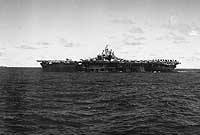 |
|
Photo #: 80-G-373737 USS Bunker Hill (CV-17) At sea during strikes against targets on Kyushu, Japan, 18 March 1945. USS New Jersey (BB-62) is in the right distance. Photographed from USS Essex (CV-9). Official U.S. Navy Photograph, now in the collections of the National Archives. Online Image: 91KB; 740 x 595 pixels Reproductions of this image may also be available through the National Archives photographic reproduction system. |
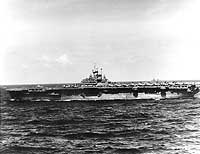 |
|
Photo #: NH 42373 USS Bunker Hill (CV-17) At sea in 1945. The original photograph is dated 16 October 1945. It has been autographed by Admiral Arleigh A. Burke, who served on board Bunker Hill in January-May 1945, while he was Chief of Staff to Admiral Marc A. Mitscher, Commander, Task Force 58. Collection of Admiral Arleigh A. Burke, USN. U.S. Naval Historical Center Photograph. Online Image: 119KB; 740 x 600 pixels |
 |
|
Photo #: 80-G-366983 Battle of the Philippine Sea, June 1944 USS Bunker Hill (CV-17) is near-missed by a Japanese bomb, during the air attacks of 19 June 1944. The Japanese plane, with its tail shot off, is about to crash, at left. Photographed from USS Monterey (CVL-26). Official U.S. Navy Photograph, now in the collections of the National Archives. Online Image: 67KB; 740 x 610 pixels Reproductions of this image may also be available through the National Archives photographic reproduction system. |
 |
|
Photo #: 80-G-274266 USS Bunker Hill (CV-17) Afire after being hit by two "Kamikaze" suicide planes off Okinawa, 11 May 1945. Photographed from USS Bataan (CVL-29). Official U.S. Navy Photograph, now in the collections of the National Archives. Online Image: 87KB; 740 x 600 pixels Reproductions of this image may also be available through the National Archives photographic reproduction system. |
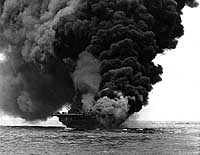 |
|
Photo #: 80-G-K-5274 (Color) USS Bunker Hill (CV-17) Burning after being hit by "Kamikaze" suicide planes during the Okinawa operation, 11 May 1945. A Cleveland class light cruiser is steaming nearby, at left. Official U.S. Navy Photograph, now in the collections of the National Archives. Online Image: 77KB; 740 x 600 pixels Reproductions of this image may also be available through the National Archives photographic reproduction system. |
 |
|
Photo #: 80-G-328618 USS Bunker Hill (CV-17) Burning after being hit by a "Kamikaze" attack while operating off Okinawa on 11 May 1945. Photographed from USS Wilkes Barre (CL-103), which appears to have received fire damage herself helping to fight the blaze from alongside the carrier. A destroyer is off Bunker Hill's port side. Official U.S. Navy Photograph, now in the collections of the National Archives. Online Image: 74KB; 740 x 605 pixels Reproductions of this image may also be available through the National Archives photographic reproduction system. |
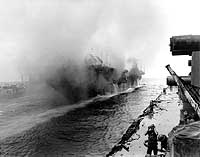 |
|
Photo #: 80-G-323712 USS Bunker Hill (CV-17) Scene on the carrier's flight deck, looking aft, while her crew was fighting fires caused by "Kamikaze" hits, off Okinawa on 11 May 1945. Official U.S. Navy Photograph, now in the collections of the National Archives. Online Image: 80KB; 740 x 565 pixels Reproductions of this image may also be available through the National Archives photographic reproduction system. |
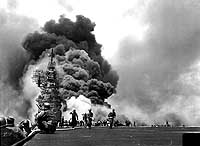 |
|
Photo #: 80-G-259904 USS Bunker Hill (CV-17) Aircraft wreckage on the flight deck, after most fires were out following hits by two "Kamikazes" off Okinawa, 11 May 1945. Official U.S. Navy Photograph, now in the collections of the National Archives. Online Image: 118KB; 740 x 610 pixels Reproductions of this image may also be available through the National Archives photographic reproduction system. |
 |
|
Photo #: USN 1150533 ex-USS Bunker Hill (ex-AVT-9) Tied up at Naval Air Station, North Island, San Diego, California, in October 1971. Though stricken from the Naval Vessel Register, she was still employed as a test platform for the Naval Electronics Laboratory Center. Official U.S. Navy Photograph. Online Image: 133KB; 740 x 545 pixels Reproductions of this image may also be available through the National Archives photographic reproduction system as Photo # 428-N-1150533. |
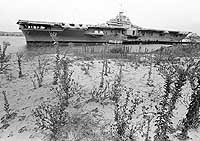 |
|
Photo #: NH 97290 USS Bunker Hill (CV-17) Afloat immediately after launching, at the Bethlehem Steel Company's Fore River yards, Quincy, Massachusetts, 7 December 1942. Several tugs are in attendance and a Navy blimp is overhead. Official U.S. Navy Photograph, from the collections of the Naval Historical Center. Online Image: 90KB; 740 x 610 pixels |
 |
| If you want higher resolution reproductions than the digital images presented here, see: "How to Obtain Photographic Reproductions." |
Page made 6 June 2000
Link added 24 September 2001